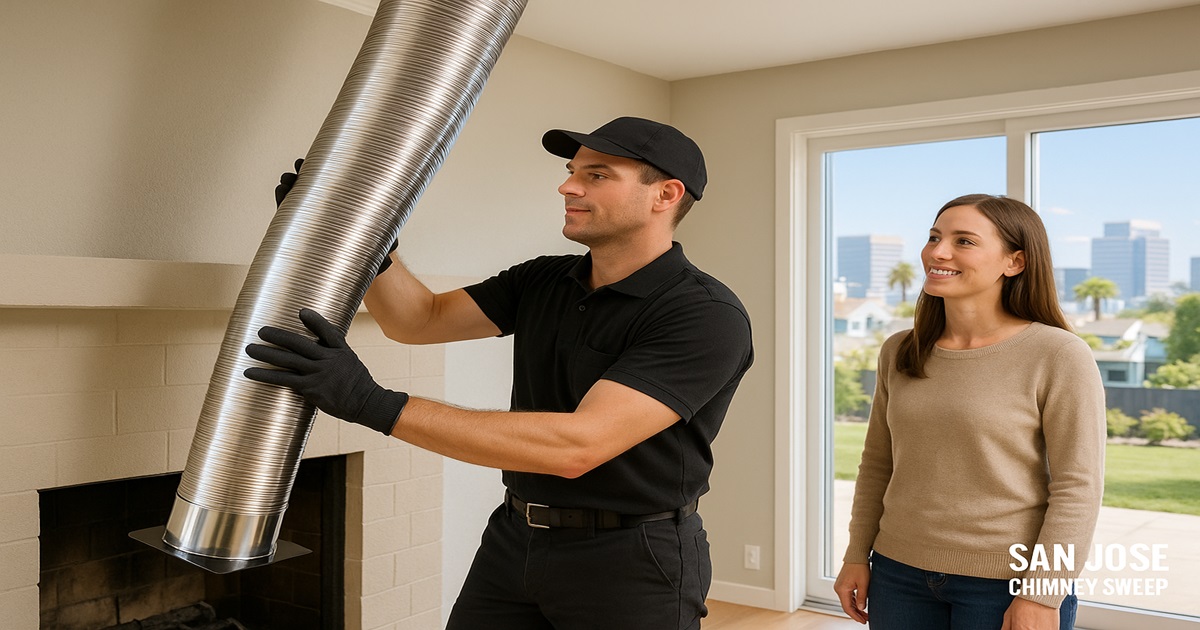When was the last time you thought about what’s inside your chimney? If you’re like most homeowners in San Jose, the answer is probably “not recently.” But tucked away in there is something called a chimney liner, and it quietly does a lot of heavy lifting to keep your home safe and your fireplace working like it should. If you’ve ever wondered if your chimney liner is due for a change, keep reading—I’ll break it down in simple terms and share what you need to know for your Bay Area home.
“Think of your chimney liner as the unsung hero—always working behind the scenes to keep your home warm, safe, and comfortable.”
Key Features: What Is the Purpose of a Chimney Liner?
Imagine your chimney liner as an invisible shield inside your chimney walls. Its job is to channel smoke, fumes, and hot gases safely out of your home while protecting the brickwork from heat and nasty stuff like creosote. Here are some of the main things it does:
- Guards the brick: It keeps heat and gases away from the bricks and mortar so they don’t crack or crumble.
- Protects your air: The liner helps make sure none of the dangerous gases sneak back into your living room.
- Improves efficiency: With a smooth liner, smoke and fumes flow out more easily, giving you a cleaner burn and less buildup.
There are a few types of liners—clay tiles, metal, and even cast-in-place cement. Each one has its own strengths and weak points, and how often you’ll need to replace yours depends on which type you have and how much you use your fireplace.
| Type of Liner | Average Lifespan | Signs It Needs Replacing |
|---|---|---|
| Clay Tile | About 15–25 years | Cracks, gaps, or crumbling tiles |
| Metal (Stainless Steel) | Up to 20 years (with good care) | Rust, warping, or holes |
| Cast-in-Place | 20–30 years | Chips, crumbling, or unstable surface |
Safety: Why Replacement Matters in San Jose
In San Jose, the weather may be milder than in snowier places, but that doesn’t mean your chimney liner gets to slack off. Even a rarely used fireplace collects soot, creosote, and moisture, which can slowly eat away at the liner. The real risk? A damaged liner can allow harmful gases, such as carbon monoxide, to enter your home or even lead to a chimney fire. Both are emergencies you want to avoid.
The best way to stay safe is to have your chimney checked every year, especially before the chillier months. A pro can spot things you’d probably miss, like tiny cracks or hidden rust. If they give you the green light, you’re good for another season. But if they spot trouble, it might be time for a new liner, no matter what the calendar says.
Cost: What Will a Chimney Liner Replacement Set You Back?
Let’s talk dollars and cents. While chimney liner replacement in San Jose can be costly, it’s a valuable investment in your home’s safety and your peace of mind. The price tag depends on a few things: the type of liner you choose, how tall your chimney is, and how tricky the installation will be. Here’s a rough idea:
- Clay tile liners: Usually less expensive, but can cost more for older or unusual chimneys.
- Stainless steel liners: A bit pricier, but they last a long time and are easier to fit into most chimneys.
- Cast-in-place liners: Most expensive, but also the most durable if you plan on living in your home for decades.
A typical replacement can run anywhere from $2,000 to $5,000, depending on what you need. If you catch issues early with regular inspections, you might save money by only needing small repairs instead of a full replacement.
Emergency Service: When Should You Call for Help?
Sometimes, waiting isn’t an option. If you notice strong, smoky smells in your house, see bits of tile or metal in your fireplace, or hear odd tapping sounds from inside your chimney, don’t put off calling a professional. These could be signs that your liner has failed and you need emergency help. In San Jose, there are companies that offer same-day service for chimney emergencies—don’t hesitate to reach out if something feels off.
Remember, an emergency doesn’t always look dramatic. Even a small crack can be a big problem if toxic gases or sparks are getting through. Trust your instincts and get it checked out.
FAQs: Your Chimney Liner Questions Answered
Q. How can I tell if it’s time to replace my chimney liner?
If you see cracked tiles, rust, weird smells, or pieces of debris in your fireplace, it’s time for a checkup. Annual inspections are the best way to know for sure.
Q. Can I replace a chimney liner myself?
It’s not a DIY job. Liner replacement can be risky and requires special tools. Leave it to the professionals for your safety.
Q. How long does a replacement take?
Most jobs can be finished in a day, but if your chimney is tall or tricky, it might take a little longer.
Q. Is there a way to make my liner last longer?
Regular cleaning and yearly inspections are the best ways to stretch the life of your liner. Steer clear of burning wet wood or household trash, as they can accelerate chimney liner damage.
Wrapping Up:
Your chimney liner might not be something you look at every day, but it’s a key part of keeping your San Jose home safe and cozy. A little attention each year goes a long way—get those inspections, keep an eye out for warning signs, and don’t be shy about asking for emergency help if you need it. You—and your loved ones—will be glad you did later on!
Read More: San Jose Chimney Sweep



